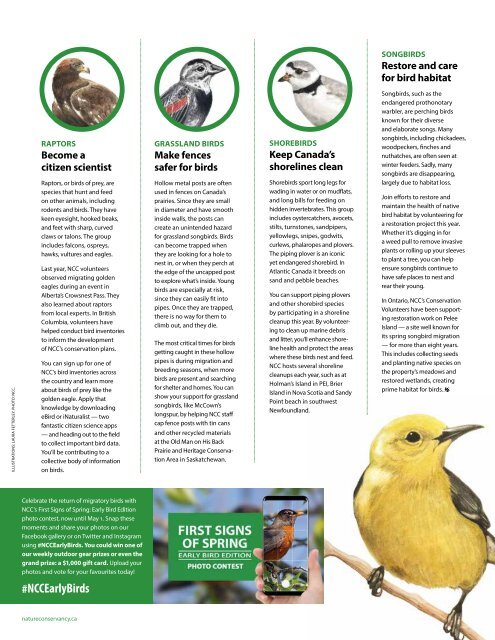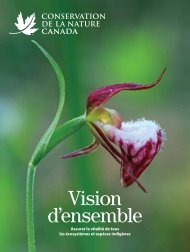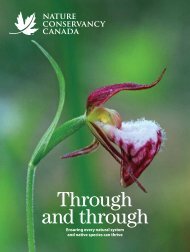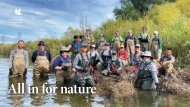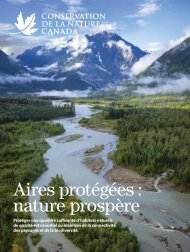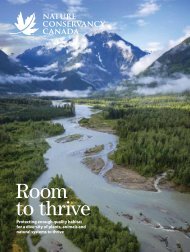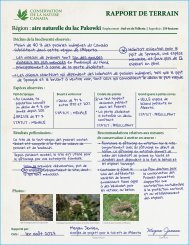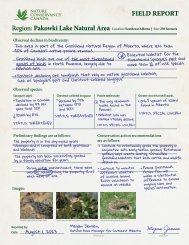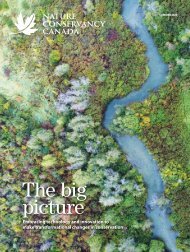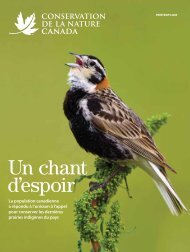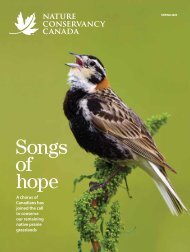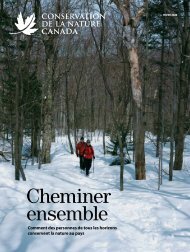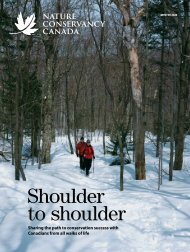Spring 2018 NCC Magazine
Create successful ePaper yourself
Turn your PDF publications into a flip-book with our unique Google optimized e-Paper software.
SONGBIRDS<br />
Restore and care<br />
for bird habitat<br />
ILLUSTRATIONS: LAURA FETTERLEY. PHOTO: <strong>NCC</strong>.<br />
RAPTORS<br />
Become a<br />
citizen scientist<br />
Raptors, or birds of prey, are<br />
species that hunt and feed<br />
on other animals, including<br />
rodents and birds. They have<br />
keen eyesight, hooked beaks,<br />
and feet with sharp, curved<br />
claws or talons. The group<br />
includes falcons, ospreys,<br />
hawks, vultures and eagles.<br />
Last year, <strong>NCC</strong> volunteers<br />
observed migrating golden<br />
eagles during an event in<br />
Alberta’s Crowsnest Pass. They<br />
also learned about raptors<br />
from local experts. In British<br />
Columbia, volunteers have<br />
helped conduct bird inventories<br />
to inform the development<br />
of <strong>NCC</strong>’s conservation plans.<br />
You can sign up for one of<br />
<strong>NCC</strong>’s bird inventories across<br />
the country and learn more<br />
about birds of prey like the<br />
golden eagle. Apply that<br />
knowledge by downloading<br />
eBird or iNaturalist — two<br />
fantastic citizen science apps<br />
— and heading out to the field<br />
to collect important bird data.<br />
You’ll be contributing to a<br />
collective body of information<br />
on birds.<br />
GRASSLAND BIRDS<br />
Make fences<br />
safer for birds<br />
Hollow metal posts are often<br />
used in fences on Canada’s<br />
prairies. Since they are small<br />
in diameter and have smooth<br />
inside walls, the posts can<br />
create an unintended hazard<br />
for grassland songbirds. Birds<br />
can become trapped when<br />
they are looking for a hole to<br />
nest in, or when they perch at<br />
the edge of the uncapped post<br />
to explore what’s inside. Young<br />
birds are especially at risk,<br />
since they can easily fit into<br />
pipes. Once they are trapped,<br />
there is no way for them to<br />
climb out, and they die.<br />
The most critical times for birds<br />
getting caught in these hollow<br />
pipes is during migration and<br />
breeding seasons, when more<br />
birds are present and searching<br />
for shelter and homes. You can<br />
show your support for grassland<br />
songbirds, like McCown’s<br />
longspur, by helping <strong>NCC</strong> staff<br />
cap fence posts with tin cans<br />
and other recycled materials<br />
at the Old Man on His Back<br />
Prairie and Heritage Conservation<br />
Area in Saskatchewan.<br />
SHOREBIRDS<br />
Keep Canada’s<br />
shorelines clean<br />
Shorebirds sport long legs for<br />
wading in water or on mudflats,<br />
and long bills for feeding on<br />
hidden invertebrates. This group<br />
includes oystercatchers, avocets,<br />
stilts, turnstones, sandpipers,<br />
yellowlegs, snipes, godwits,<br />
curlews, phalaropes and plovers.<br />
The piping plover is an iconic<br />
yet endangered shorebird. In<br />
Atlantic Canada it breeds on<br />
sand and pebble beaches.<br />
You can support piping plovers<br />
and other shorebird species<br />
by participating in a shoreline<br />
cleanup this year. By volunteering<br />
to clean up marine debris<br />
and litter, you’ll enhance shoreline<br />
health and protect the areas<br />
where these birds nest and feed.<br />
<strong>NCC</strong> hosts several shoreline<br />
cleanups each year, such as at<br />
Holman’s Island in PEI, Brier<br />
Island in Nova Scotia and Sandy<br />
Point beach in southwest<br />
Newfoundland.<br />
Songbirds, such as the<br />
endangered prothonotary<br />
warbler, are perching birds<br />
known for their diverse<br />
and elaborate songs. Many<br />
songbirds, including chickadees,<br />
woodpeckers, finches and<br />
nuthatches, are often seen at<br />
winter feeders. Sadly, many<br />
songbirds are disappearing,<br />
largely due to habitat loss.<br />
Join efforts to restore and<br />
maintain the health of native<br />
bird habitat by volunteering for<br />
a restoration project this year.<br />
Whether it’s digging in for<br />
a weed pull to remove invasive<br />
plants or rolling up your sleeves<br />
to plant a tree, you can help<br />
ensure songbirds continue to<br />
have safe places to nest and<br />
rear their young.<br />
In Ontario, <strong>NCC</strong>’s Conservation<br />
Volunteers have been supporting<br />
restoration work on Pelee<br />
Island — a site well known for<br />
its spring songbird migration<br />
— for more than eight years.<br />
This includes collecting seeds<br />
and planting native species on<br />
the property’s meadows and<br />
restored wetlands, creating<br />
prime habitat for birds.1<br />
Celebrate the return of migratory birds with<br />
<strong>NCC</strong>’s First Signs of <strong>Spring</strong>: Early Bird Edition<br />
photo contest, now until May 1. Snap these<br />
moments and share your photos on our<br />
Facebook gallery or on Twitter and Instagram<br />
using #<strong>NCC</strong>EarlyBirds. You could win one of<br />
our weekly outdoor gear prizes or even the<br />
grand prize: a $1,000 gift card. Upload your<br />
photos and vote for your favourites today!<br />
#<strong>NCC</strong>EarlyBirds<br />
natureconservancy.ca


